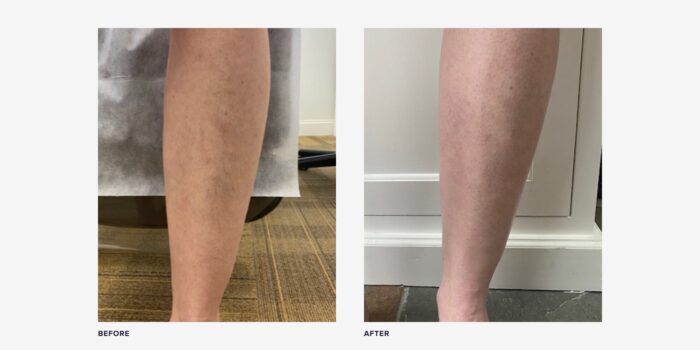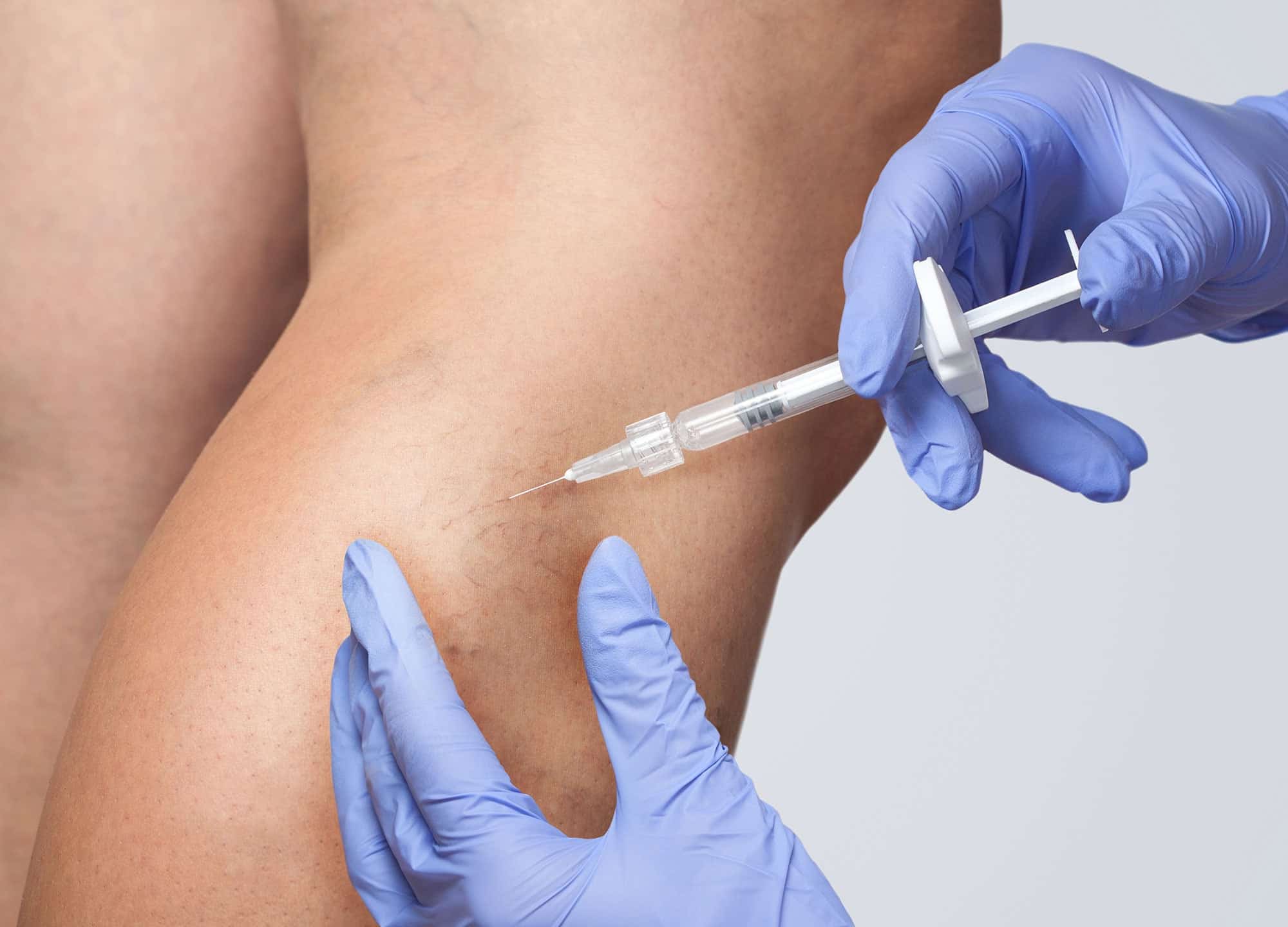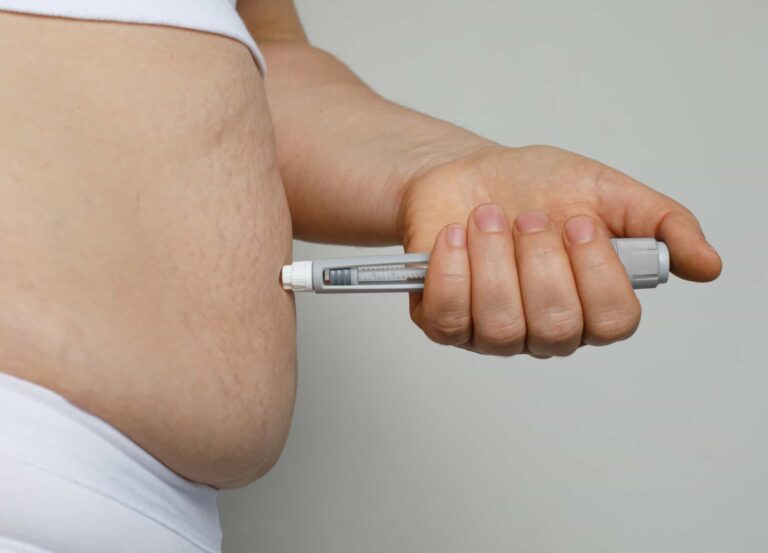Early last summer, as I pulled on my favorite cutoffs for their inaugural wear, I noticed a tangle of capillaries staining the pale expanse of my left shin. The veins, inky and thready like my shorts, weren’t exactly new, but they seemed to have taken on a fresh intensity, as if they’d been incubating all winter while cocooned in fleece and denim. Believing in the palliative power of a good moisturizer, I smeared on a generous glob, but it did little more than make the cobwebby vessels glisten in the revealing June light.
Since I had a Botox appointment scheduled for the following week, I texted board-certified Boston dermatologist Dr. Papri Sarkar, to see if she’d also have time for a little sclerotherapy—the injecting of spider veins with a detergent-like solution, to cause their eventual collapse. She reminded me, on that 90℉ morning, that it’s better to treat veins in the fall or winter, because the aftercare involves hot, compressive support hosiery—a fact that left me in a bit of a bind. “Nobody notices the veins until summer,” she wrote, “when they are so very hard to treat.”
I heeded her advice, booking my first sclero session in December and my second, five weeks later, in January.
What causes spider veins?
Telangiectasias, or spider veins, are essentially bloated capillaries with inefficient valves. In the legs, “veins are fighting gravity to return blood to the heart,” Dr. Sarkar explains. They get an assist from valves, which aim to keep blood moving in a one-way fashion. But if the valves become faulty—due to age, genetics, pregnancy, prolonged sitting—blood can pool in the vessels, causing them to swell. “When this happens, deeper veins can enlarge, but the ones people generally notice are the tiny superficial ones nearest to the skin,” says Dr. Sarkar. “When those dilate, the network of vessels often looks like a spider, hence the name.” Since these small, shallow vessels aren’t critical for venous return, they can be destroyed without consequence.
How sclerotherapy gets rid of spider veins
Dr. Sarkar typically uses an FDA-approved sclerosing agent called Asclera or polidocanol. “When injected into a vein, it causes irritation to the innermost lining, making it jagged,” she tells me. “Because the lining isn’t smooth anymore, the different cells that are in the blood catch on the lining and form a small clot in the vein, which causes it to close. Once it’s sealed off, the body scavenges the different parts of the vein, metabolizes it, and replaces it with normal skin.” The whole process—from shot to clearance—can take upwards of six weeks.
Sclerotherapy works best on vessels of a certain size. “Ideally, you want a vein that’s 0.05 to 1 millimeter in diameter,” according to Dr. Sarkar. Most of mine were less than a millimeter—small but not so miniscule that the needle tip can’t penetrate them (which can be a problem with the teensiest vessels). Veins that measure more than a few millimeters in diameter can be risky to treat with sclero. “If veins are too big, you can affect the rest of the circulatory system, close a vein that is necessary for functioning, or give someone a clot that might travel,” Dr. Sarkar explains. “In smaller veins, this is unlikely, as they easily collapse onto themselves and aren’t a path of transport for clots.” (When patients present with larger veins, she refers them to a vascular surgeon for endovenous laser ablation or, sometimes, vein stripping.)
What it’s like to get sclerotherapy
In my opinion, once you’ve had your face injected with filler, needle pokes on the body become fairly breezy. Which isn’t to say that sclerotherapy is a painless procedure—it’s not: a sharp needle is repeatedly piercing your unanesthetized* skin and releasing droplets of detergent into your veins. (I’m not one to sugarcoat.) Still, if filler injections are, say, a 7 on the beauty pain scale, sclero is more like a 2 or 3, in my experience. Weirdly, some sticks hurt worse than others. Throughout most of the treatment, I was chatting and laughing and feeling next to nothing, but occasionally—whoa!—I’d have to breathe deeply and go to my happy place for a bit.
(*“Numbing is tricky,” says Dr. Sarkar, “because it shrinks the vessels a bit and causes swelling.” Xanax or Valium are better options for those who are worried about the pain of sclero.)
Following my appointment, I had no lingering discomfort, but my legs looked pretty beat up for a couple of weeks. “Normally after the treatment, the patient feels fine, but the legs may be red or have small areas that look like bites or hives,” Dr. Sarkar says. “The initial bumpiness usually resolves within a few days, but the redness can persist for a week or two.”
Since all my spider veins were localized to my lower legs, Dr. Sarkar had me wear compression knee socks with a pressure level of 20–30 MmHg day and night, for two weeks, to prevent the treated veins from refilling with blood and potentially expanding again. She recommended taking several short, brisk walks, for at least the first few days after treatment, to activate my leg muscles and keep the blood pumping. She also insisted that I refrain from using my Peloton for two weeks—and generally “avoid anything that can cause a significant increase in dilation of the vessels in the lower legs, including biking, HIIT classes, running, and even things like a warm bath, a sauna, hot compresses, or sunbathing,” she says.
The risks of sclerotherapy
When performed by an experienced board-certified dermatologist, sclerotherapy is a safe procedure—but, of course, no treatment is without risks. The main ones with sclerotherapy include recurrence (veins reappearing years later), ulcers, hyperpigmentation, and neurological events, which are exceedingly rare and more apt to occur in people with a history of clotting.
Along with your provider’s skill level, the sclerosing agent they choose can influence your chance of complications. Dr. Sarkar finds Asclera to be safe, effective, and less stinging than most other solutions. The sclerosant drug, sodium tetradecyl sulfate (STS), is another good choice with a similar side-effect profile, she says. Some doctors are partial to hypertonic saline, she tells us, because it “works like gangbusters and virtually no one is allergic to it.” It’s not FDA-approved for sclerotherapy, however, and “it burns and can sometimes cause cramping when you inject it into a vein,” she notes.
Should your injector miss the intended vein, you could develop an ulcer. “Ulcers look like bone- or porcelain-white spots on the skin that are sometimes indented,” says Dr. Sarkar. “They can also lead to hyperpigmentation, or dark marks, in people who are given to healing that way, like patients of color or folks who tan very easily.”
While all sclero solutions can cause ulcers if they’re mistakenly injected into the dermis instead of a vein, says Dr. Sarkar, they tend to occur more frequently with hypertonic saline than with routine concentrations of Asclera or STS.
As for the normal and expected side effects of treatment, there’s swelling, redness, bruising, itching, injection site pain, and incomplete treatment, which “is relatively common because providers usually limit how much solution they inject and how much surface area they treat per visit,” she explains. So again, you’ll likely want to plan for two rounds of sclerotherapy.
My sclerotherapy results
I’m about two weeks out from my second session and happy to report that the web of capillaries that caught my eye last summer has totally disappeared. While Dr. Sarkar also treated discrete spider veins on the fronts and backs of both of my lower legs, the sprawling patch that drove me to sclero was definitely the most obvious—and its absence is now similarly striking. (Zoom in for a closer look.)

My second round of shots was like a touch-up treatment, during which Dr. Sarkar targeted any tiny, superficial vessels that were still hanging around. Not all of them have cleared yet, but as she mentioned, it can take four to six weeks for the body to break them down after sclerotherapy, so I’m expecting to see further improvement over time.
Sclero is not an instant fix—this bears repeating—and your legs will absolutely look worse before they look better. Try not to judge your results too soon. Only after the redness and bruises have faded and your body has done away with the damaged vessels, can you really gauge the success of your procedure. Personally, I’m thrilled with my results and am already feeling more confident about bearing my legs. I’ll be adding sclero to my list of routine maintenance treatments, to hopefully stop spider veins from creeping up on me, full force, in the future.











